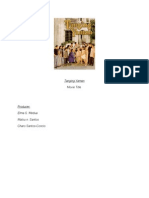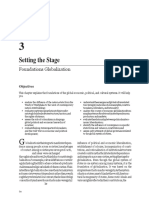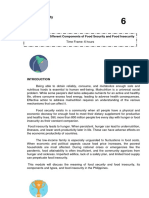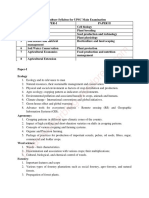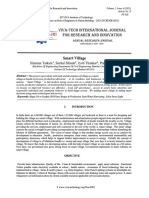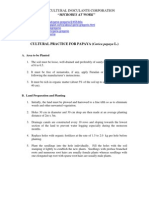Importance of Biodiversity To Human
Importance of Biodiversity To Human
Uploaded by
Baxter ValCopyright:
Available Formats
Importance of Biodiversity To Human
Importance of Biodiversity To Human
Uploaded by
Baxter ValOriginal Description:
Original Title
Copyright
Available Formats
Share this document
Did you find this document useful?
Is this content inappropriate?
Copyright:
Available Formats
Importance of Biodiversity To Human
Importance of Biodiversity To Human
Uploaded by
Baxter ValCopyright:
Available Formats
The importance of biodiversity to human
health
Health is our most basic human right. For most people, it
does not just mean freedom from illness, but a state of
overall social, emotional, physical, spiritual and cultural
welfare. Being well, and having the capacity to look after
our health and that of our family or community, depends
upon a range of factors, including our economic status
and ultimately on our environment. Health is therefore one
of the most important indicators of sustainable
development.
Biodiversity is the foundation for human health. By
securing the life-sustaining goods and services which biodiversity provides to us, the conservation and sustainable
use of biodiversity can provide significant benefits to our health. In contrast, the continuing loss of biodiversity on a
global scale represents a direct threat to our health and well-being. Without a global environment that is healthy
and capable of supporting a diversity of life, no human population can exist.
The reports of the Millennium Ecosystem Assessment and the Intergovernmental Panel on Climate Change have
highlighted how human well-being is affected by the state of the global environment and the sustainability of
ecosystems. However, the enormous range of benefits which biodiversity provides to our health and well-being is
largely underappreciated and unrecognised within the health community, and fails to inform critical decisions on
global and regional health strategies. At the same time, the wider social and public health importance of
biodiversity is not always understood by those concerned with biodiversity conservation.
Biodiversity supports food security, dietary health, livelihood sustainability
Genetic diversity in food systems provides the foundation of crop development and food security, and promotes
resistance and resilience to environmental stresses including pests and diseases of crops and livestock. Diets
based on a diversity of food species promote health, and can help to protect against disease by addressing the
problem of micronutrient and vitamin deficiencies. Loss of agricultural biodiversity can therefore threaten health,
livelihood sustainability and our future security of food and nutrition.
Biodiversity provides important resources for medical research
Studies of wildlife anatomy, physiology and biochemistry can lead to important developments in human medicine.
Examples of species of interest to medical science include bears (for insights into osteoporosis, cardio-vascular
disorders, renal disease and diabetes), sharks (osmoregulation and immunology), cetaceans (respiration and
treatments for divers suffering from decompression sickness) and horse-shoe crabs (optometry / ophthalmology
and molecular cell biology).
Biodiversity provides important resources for traditional and modern medicine
Biodiversity loss can impact on community traditions and
livelihoods centred on traditional medicinal practices that
utilise wild animals and plants, particularly for indigenous
and local communities. Millions of people depend upon
traditional medicines for their primary health care.
Modern drugs derived from wild species include inter alia
pain killers (e.g. Zinconitide from cone snail toxin), cardiac
drugs (e.g. Lanoxin from Digitalis plants), anti-cancer
drugs (e.g. Taxol from Taxus trees and Hycamtin from
Camptotheca t es) and treatments for diabetes (including
Exanitide from Heloderma lizards). Many other potentially
re
important species are yet to be investigated or discovered.
Biodiversity plays a role in the regulation and control of infectious diseases
Biodiversity loss and ecosystem change can increase the
risk of emergence or spread of infectious diseases in
animals, plants and humans, including economically
important livestock diseases, zoonotic outbreaks and
global pandemics. In recent years outbreaks of SARS,
Ebola, Marburg, Hantavirus pulmonary syndrome, avian
influenza and malaria have been attributed to human
impacts on biodiversity, the wildlife trade or unsustainable
land use change. Without a greater understanding of
disease ecology, there is also a risk that programmes to
tackle infectious diseases may impact negatively on
biodiversity, through use of biocides and other chemicals
and wildlife culls.
Biodiversity has social, cultural and spiritual importance within communities
Ecosystem change can result in disconnection of populations from open spaces or the wider countryside, with
negative implications for physical and mental well-being and loss of sense of place. This has been linked to an
increased prevalence of diseases of affluence (diabetes, obesity, cardio-pulmonary illness) and psychological
disorders in many communities. Conversely, access to greenspace (natural and artificial) are associated with
better health outcomes, shorter hospital visits and reduced convalescence time for patients than purely urban
environments. An awareness of environmental values and respect for other species has been associated with
reduced propensity towards anti-social behaviour in children and young adults.
Conservation of biodiversity is essential for climate change adaptation
Climate change will have a range of significant impacts on human health, many of which are directly associated
with climate impacts on ecosystems. For example, changes in the ecology of pathogens, or in the populations or
distribution of disease vectors such as mosquitoes, could lead to changes in disease patterns and increase the
risk of outbreaks. Loss of ecosystem services also places communities at greater risk from other climate impacts,
such as extreme weather events, drought and crop failure.
Intact ecosystems can reduce disaster risks and support relief and recovery efforts
Biodiversity and healthy ecosystems can provide important natural buffers against natural disasters such as
floods, drought and landslides. Habitat loss is also a contributory factor in desertification and dryland salinity,
impacting on livelihoods community stability. Those who
are poor or sick, or who experience low levels of livelihood
security, are likely to be at greatest risk from such events.
In many regions, rural communities and the poor are
typically more dependent upon ecosystems for their
livelihood security and well-being, and they are therefore
most vulnerable to the impact of disasters if these
ecosystems are compromised before or by disaster
impacts. People who have been displaced by disaster or
conflict may be more susceptible to illness, and more
dependent on ecosystem services for food, shelter and
medicine. Sustainable management of biodiversity can
help to provide essential resources for promoting health
and rebuilding livelihoods in post-crisis situations.
About COHAB
The COHAB Initiative (Co-operation on Health and Biodiversity) is an international programme of work established
to address the gaps in awareness, policy and action on the links between human health and well-being and the
conservation of biological diversity. The Secretariat of the COHAB Initiative is based in Galway, Ireland. Visit
www.cohabnet.org or email info@cohabnet.org for more information.
You might also like
- CB Sample - Environmental Management - Marketingweb PDFDocument32 pagesCB Sample - Environmental Management - Marketingweb PDFMazanda Yalindua100% (2)
- Biodiversity and The Healthy SocietyDocument3 pagesBiodiversity and The Healthy SocietyKJ PacamparaNo ratings yet
- Module-1 Contemporary WorldDocument7 pagesModule-1 Contemporary WorldRaniel Galindo0% (1)
- Unit Vi - Towards A Sustainable WorldDocument9 pagesUnit Vi - Towards A Sustainable WorldAngela Daphnie ToribioNo ratings yet
- The Agricultural RevolutionDocument16 pagesThe Agricultural Revolutionashoku24007No ratings yet
- Biodiversity & Its TypesDocument9 pagesBiodiversity & Its Typesakhileshmoney73% (11)
- The Importance of BiodiversityDocument2 pagesThe Importance of BiodiversityLily Sharma100% (1)
- CHAPTER 11 A World of Ides Global Media CulturesDocument26 pagesCHAPTER 11 A World of Ides Global Media CulturesAj PajimulaNo ratings yet
- GENELECT2 - Lesson 4 Species Interactions, Ecological Succession, and Population ControlDocument40 pagesGENELECT2 - Lesson 4 Species Interactions, Ecological Succession, and Population ControlCamela Grace CabilaoNo ratings yet
- Pisa - Reading Literacy: English Language LearningDocument7 pagesPisa - Reading Literacy: English Language LearningAlmauliddio0% (1)
- Group 5 Global Food SecurityDocument12 pagesGroup 5 Global Food SecuritySean Kenneth RosarosoNo ratings yet
- The Global Divides: The North and SouthDocument18 pagesThe Global Divides: The North and SouthDianna BautistaNo ratings yet
- Guide Questions Page 41Document2 pagesGuide Questions Page 41Shelley CasaoNo ratings yet
- Presentation1 1Document37 pagesPresentation1 1NinaGonzalesNo ratings yet
- Global Food Security (The Challenge of Feeding The World)Document31 pagesGlobal Food Security (The Challenge of Feeding The World)Amy PinedaNo ratings yet
- KITANGLADDocument18 pagesKITANGLADJASMIN DAMIANNo ratings yet
- Chapter 3 - Ecological RelationshipsDocument35 pagesChapter 3 - Ecological RelationshipsJudy Ann SibayanNo ratings yet
- Environment and Sustainable DevelopmentDocument3 pagesEnvironment and Sustainable DevelopmentAmicable VanuNo ratings yet
- Contempory Global GovernaceDocument36 pagesContempory Global GovernaceRodlan DiponNo ratings yet
- Introduction 1docxDocument4 pagesIntroduction 1docxKyle Verano SabueroNo ratings yet
- Political GlobalizationDocument18 pagesPolitical GlobalizationsaveezaNo ratings yet
- ACTIVITIES The Contemporary WorldDocument1 pageACTIVITIES The Contemporary WorldAnnalyn EndrinalNo ratings yet
- 7 Environmental PrinciplesDocument26 pages7 Environmental PrinciplesDaxNo ratings yet
- Tanging YamanDocument4 pagesTanging YamanRoxanne ArellanoNo ratings yet
- Ge 102 Contemporary World Module 2Document14 pagesGe 102 Contemporary World Module 2Selene Acosta100% (1)
- (Final) Role of The Youth in Environmental ProtectionDocument23 pages(Final) Role of The Youth in Environmental ProtectionVeeny BautistaNo ratings yet
- Chapter 3Document15 pagesChapter 3Johannin Arevalo- Celada100% (1)
- Globalization PrentationDocument26 pagesGlobalization Prentationhayat hanimNo ratings yet
- Climate Change RevDocument6 pagesClimate Change RevMichelle MalabananNo ratings yet
- Reading 2 Foundations of Globalization ChiricoDocument26 pagesReading 2 Foundations of Globalization ChiricoVivienne LayronNo ratings yet
- BIODIVERSITY AND THE HEALTHY SOCIETY-WPS OfficeDocument16 pagesBIODIVERSITY AND THE HEALTHY SOCIETY-WPS OfficeJesslie PiolNo ratings yet
- Sts Module 5 AssignmentDocument4 pagesSts Module 5 AssignmentAji Love SuropiaNo ratings yet
- Population EcologyDocument15 pagesPopulation EcologyAshraf0% (1)
- 5 Towards A Sustainable WorldDocument24 pages5 Towards A Sustainable WorldJoshua Ardie MesinaNo ratings yet
- Environmental Science Week No.1 2Document18 pagesEnvironmental Science Week No.1 2Mayla G. BalayonNo ratings yet
- Underlying Philosopies of GlobalizationDocument14 pagesUnderlying Philosopies of GlobalizationMacaullyn Victor Garcia IVNo ratings yet
- Global Food Security TCWDocument9 pagesGlobal Food Security TCWCHRISTIAN DUMANGASNo ratings yet
- Contemporary World OutlineDocument5 pagesContemporary World OutlineJeffrey CabarrubiasNo ratings yet
- Ecological BalanceDocument2 pagesEcological BalanceDiana Jane Gare100% (1)
- Module 6 Food InsecurityDocument10 pagesModule 6 Food InsecurityNizea Camille Navarro JavierNo ratings yet
- Philippine Social History: Global Trade and Local TransformationsDocument6 pagesPhilippine Social History: Global Trade and Local TransformationsJenny HermosadoNo ratings yet
- Module For The Contemporary World 2020Document133 pagesModule For The Contemporary World 2020Shen Eugenio100% (1)
- Globalization Cultural ImperialismDocument14 pagesGlobalization Cultural ImperialismKristia EchinNo ratings yet
- The Contemporary World Act. 2Document2 pagesThe Contemporary World Act. 2Jervyn GuiananNo ratings yet
- Assignment 2 THE HUMAN IMPACT ON VEGETATIONDocument1 pageAssignment 2 THE HUMAN IMPACT ON VEGETATIONChristopher EgeNo ratings yet
- Module 4 - GENEALOGICAL AND CULTURAL CONNECTIONS OF THE TRI-PEOPLE OF MINSUPALADocument18 pagesModule 4 - GENEALOGICAL AND CULTURAL CONNECTIONS OF THE TRI-PEOPLE OF MINSUPALAczelleah de gracia100% (1)
- The Global Divides:: The North and The SouthDocument16 pagesThe Global Divides:: The North and The SouthJessa Marie EnriquezNo ratings yet
- Module 1 To 4 Reflection Paper On CWTS (1ST Sem)Document2 pagesModule 1 To 4 Reflection Paper On CWTS (1ST Sem)bmaria krizzaNo ratings yet
- Effects of Globalization To GovernmentsDocument21 pagesEffects of Globalization To GovernmentsKimberly Punzalan BurgosNo ratings yet
- Battle of Tirad Wps OfficeDocument24 pagesBattle of Tirad Wps OfficeTAN MARIEL S.No ratings yet
- Contemporary World PrelimsDocument38 pagesContemporary World PrelimsJorge LabanteNo ratings yet
- Haribon ProjectDocument14 pagesHaribon ProjectKhiya Llanes100% (1)
- GLOBA EssayDocument2 pagesGLOBA EssayJames Vidad100% (1)
- Canate, Judy Ann L. BSIT-201Document6 pagesCanate, Judy Ann L. BSIT-201Jomarie canateNo ratings yet
- Effects of TsunamiDocument3 pagesEffects of TsunamiMelissa Brown100% (1)
- Secsem Worksheet 4 TBCDocument6 pagesSecsem Worksheet 4 TBCSpearB100% (1)
- Group 5: Japanese CultureDocument13 pagesGroup 5: Japanese CultureAAAAANo ratings yet
- Global Market Integration Module 3Document3 pagesGlobal Market Integration Module 3Erika Joyce RunasNo ratings yet
- Development of Science and Technology Throughout HistoryDocument1 pageDevelopment of Science and Technology Throughout History찹찹찹No ratings yet
- Cohab Policy Brief1 en (1)Document2 pagesCohab Policy Brief1 en (1)Sauquillo Rose ShaneNo ratings yet
- Agriculture Syllabus - Break Up PalsDocument5 pagesAgriculture Syllabus - Break Up PalsDivyanshi SinghNo ratings yet
- Smart VillageDocument3 pagesSmart VillageVIVA-TECH IJRINo ratings yet
- 4.3 Carbon CycleDocument10 pages4.3 Carbon Cyclecamila hartmannNo ratings yet
- SurThrival Growing Guide 2nd Edition Complete-ADocument54 pagesSurThrival Growing Guide 2nd Edition Complete-APaul GhingaNo ratings yet
- Data Organization: LAST UPDATE 14-03-2019 BY RAPPDocument7 pagesData Organization: LAST UPDATE 14-03-2019 BY RAPPAlexNo ratings yet
- Soil Microbial Biomass-What Do The Numbers Really Mean?: Australian Journal of Experimental Agriculture January 1998Document19 pagesSoil Microbial Biomass-What Do The Numbers Really Mean?: Australian Journal of Experimental Agriculture January 1998Gerad ValdezNo ratings yet
- Cve 502 Oyebode Water and Wastewater Lecture 2022-2023Document368 pagesCve 502 Oyebode Water and Wastewater Lecture 2022-2023Adegoke samuel charlesNo ratings yet
- FINAL NOTES Geography G110 - Introduction To Human Geography PDFDocument158 pagesFINAL NOTES Geography G110 - Introduction To Human Geography PDFtrecia mae cadizNo ratings yet
- Silakan BacaDocument5 pagesSilakan BacaSu CiNo ratings yet
- Rain Water HarvestingDocument20 pagesRain Water HarvestingMishul GuptaNo ratings yet
- ICNS 2023 Jabalpur 1.4Document10 pagesICNS 2023 Jabalpur 1.4rajnishNo ratings yet
- Invasive SpeciesDocument5 pagesInvasive SpeciesJover NuevaespañaNo ratings yet
- Reporters and ReactorsDocument8 pagesReporters and ReactorsLiway PabloNo ratings yet
- Petition For Issuance of The Writ of KalikasanDocument12 pagesPetition For Issuance of The Writ of KalikasanInnoKalNo ratings yet
- Nuvali & Treveia PresentationDocument66 pagesNuvali & Treveia PresentationNoemi Lardizabal-Dado100% (1)
- Climate Change: by Kimberly .N. ChishiriDocument10 pagesClimate Change: by Kimberly .N. ChishirikevitynoeNo ratings yet
- SUSTAINABLE DEVELOPMENT Environmental Law Roll No 4 Pratiksha BhagatDocument26 pagesSUSTAINABLE DEVELOPMENT Environmental Law Roll No 4 Pratiksha Bhagatpratiksha lakdeNo ratings yet
- Concept of Sustainable TourismDocument3 pagesConcept of Sustainable TourismBianca UmaliNo ratings yet
- Government Agencies and SectorsDocument5 pagesGovernment Agencies and SectorsJoan Mae Ofril JumawanNo ratings yet
- Pollution Status and Trends in Water Quality of The Shitalakhya and Balu RiversDocument19 pagesPollution Status and Trends in Water Quality of The Shitalakhya and Balu RiversZisan AhmedNo ratings yet
- National Law Institute University BhopalDocument30 pagesNational Law Institute University BhopalVicky DNo ratings yet
- Combined Hs229Document74 pagesCombined Hs229shubhamNo ratings yet
- Adlabs Imagica WRDDocument14 pagesAdlabs Imagica WRDNikhil SonawaneNo ratings yet
- ES Q2 Lesson 12 Weathering, Erosion and Mass WastingDocument8 pagesES Q2 Lesson 12 Weathering, Erosion and Mass Wastingautumn leavsNo ratings yet
- AIC Organic Fertilizer For PapayaDocument2 pagesAIC Organic Fertilizer For PapayaGene GregorioNo ratings yet
- Impact of Climate Change On Coastal Agriculture - An Analytical Study in Thiruvallur DistrictDocument17 pagesImpact of Climate Change On Coastal Agriculture - An Analytical Study in Thiruvallur DistrictArularasi ArumaidasNo ratings yet
- 10th Carbon Crunch A Systems Approach To CCDocument40 pages10th Carbon Crunch A Systems Approach To CCtwat neckNo ratings yet
- Guidance Document On Assessment of Plans and Projects-KH0122028ENNDocument14 pagesGuidance Document On Assessment of Plans and Projects-KH0122028ENNtexas_peteNo ratings yet
- GeorgiaDocument2 pagesGeorgiaLAURENȚIU GABRIEL CRISTEANo ratings yet























